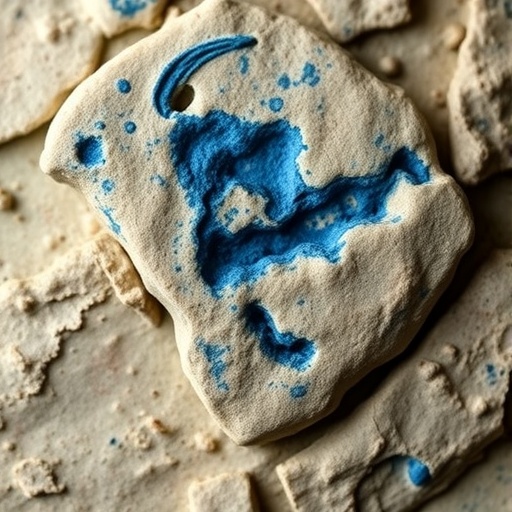A groundbreaking discovery at the Final Palaeolithic archaeological site of Mühlheim-Dietesheim in Germany has revealed the earliest evidence of blue pigment use in Europe, fundamentally challenging long-held assumptions about the color palettes of prehistoric human societies. Archaeologists from Aarhus University uncovered traces of a vivid blue mineral pigment, identified as azurite, on a stone artifact dating back approximately 13,000 years. This finding, validated through a suite of advanced scientific analyses, marks the first confirmed presence of blue pigment in Palaeolithic art across the continent, a revelation that opens new pathways for understanding prehistoric symbolic and aesthetic practices.
For decades, scholars believed that the color usage in Palaeolithic art was predominantly confined to the stark contrasts of red and black pigments. These colors, primarily derived from ochre and charcoal, dominated cave paintings, engravings, and body decorations from the period. The near absence of blue pigments was traditionally ascribed to the scarcity of suitable blue minerals in the natural environment or the perceived limited visual or symbolic significance of blue hues to early humans. However, this new evidence from Mühlheim-Dietesheim unequivocally demonstrates that Palaeolithic artists possessed both the knowledge and means to source and manipulate a broader spectrum of mineral pigments than previously documented.
The identification of azurite, a copper carbonate mineral known for its deep blue coloration, on a stone tool initially presumed to function as an oil lamp, suggests alternative interpretations of its use. Detailed microscopic and spectrometric analyses, including Raman spectroscopy and X-ray fluorescence (XRF), revealed pigment residues indicative of deliberate application and preparation rather than incidental contamination. This artifact, now hypothesized to be a pigment mixing palette rather than a simple lighting device, implies a sophisticated understanding of pigment processing techniques among Palaeolithic populations.
Importantly, the presence of azurite indicates that prehistoric people were not merely passive collectors of naturally occurring pigments but engaged in selective extraction and processing of minerals for specific purposes. The methodical preparation of blue pigments challenges the assumption that Palaeolithic color usage was utilitarian or symbolic only in limited hues. Instead, it posits a complex cultural dimension where color choice could convey nuanced meanings related to identity, status, ritual, or aesthetics, although concrete interpretations remain speculative given the ephemeral nature of many such practices.
One intriguing implication of the discovery concerns the possible use of blue pigments beyond cave art. Because the archaeological record contains scant remains of textiles or body decoration from this era, the application of luminous pigments like azurite for dyeing fabrics or marking skin may have been culturally significant yet left minimal traces. This could account for the historical invisibility of blue in Palaeolithic artifacts and calls for a reevaluation of methodologies in detecting and interpreting pigment residues in early archaeological contexts.
Dr. Izzy Wisher, lead author of the study, emphasizes that this finding revolutionizes our understanding of prehistoric visual communication. According to Wisher, the expertise required to procure and process azurite reveals a detailed mineralogical knowledge and an aesthetic sophistication previously unappreciated in Palaeolithic societies. The deliberate use of blue pigments broadens the recognized intellectual and material repertoire of early humans, reinforcing the notion that they engaged with their environment in innovative and culturally expressive ways.
Technical analysis conducted at Aarhus University incorporated interdisciplinary collaboration, combining archaeological expertise with advanced geochemical and mineralogical methods. Researchers employed non-destructive imaging and chemical characterization to delineate pigment composition accurately. These approaches enabled the distinction between indigenous residues and contamination, substantiating the anthropogenic origin of the azurite traces. Moreover, the collaborative input from international experts in Germany, Sweden, and France contributed to a comprehensive contextualization of the findings within the broader Palaeolithic framework.
The reinterpretation of the stone artifact as a pigment palette sheds light on possible artistic or cosmetic traditions during the Late Glacial period. The palette likely served as a preparation surface for pigment mixtures, facilitating activities such as body painting, fabric dyeing, or portable art production. This functional reassessment aligns with ethnographic parallels where pigment mixing palettes are integral to cultural practices, signaling continuity in human material culture strategies.
This discovery challenges not only pigment-related assumptions but also broader perspectives on symbolic behavior in early human societies. By documenting access to and usage of diverse mineral pigments, the research urges scholars to reconceptualize the cognitive and cultural capacities of Palaeolithic people. It opens avenues for investigating how color might have contributed to social dynamics, identity construction, and the negotiation of status within hunter-gatherer groups, thereby enriching narratives of prehistoric life.
Furthermore, the find highlights the necessity of adopting cutting-edge scientific techniques in archaeology to unlock nuanced insights from material residues often overlooked by conventional analysis. It suggests that other unexplored or re-examined artifacts may harbor latent chemical signatures of pigments, urging a reexamination of Palaeolithic artifact assemblages through the lens of pigmentology.
Overall, the earliest evidence of blue pigment use in Europe, as demonstrated by this multidisciplinary study, reframes the visual and symbolic landscape of prehistoric humans. It underscores an intricate interplay between natural resource knowledge, technical skill, and cultural expression, painting a more vibrant and complex picture of Palaeolithic artistic and social life than previously imagined.
The full findings are detailed in a study published in the journal Antiquity, available via DOI: 10.15184/aqy.2025.10184, inviting further discourse and investigation into the role of pigments in human prehistory.
Subject of Research: The utilization and cultural significance of blue mineral pigments in Palaeolithic Europe
Article Title: The earliest evidence of blue pigment use in Europe
News Publication Date: 29-Sep-2025
Web References: https://doi.org/10.15184/aqy.2025.10184
Keywords: Archaeology, Palaeolithic art, azurite, pigment use, prehistoric symbolism, mineral pigments




